A quarter-century into the internet age, we sophisticates have pretty much trained our eyes to ignore online display ads. And if the product is life insurance, of all things? Instant glaze-over.
And yet, I couldn’t ignore a series of Health I.Q. ads on the Google Display Network. The ads struck me as particularly effective in a highly competitive industry that saturates every conceivable medium. Here’s a sample:
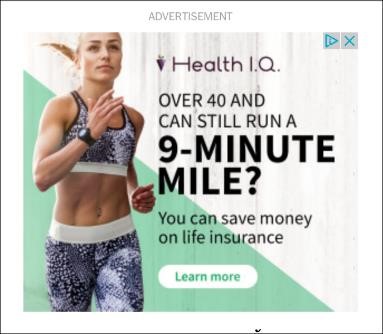
Let’s look into this surprisingly memorable campaign, which offers seven takeaways to any party seeking more effective online advertising. (Full disclosure: I have absolutely no connection, financial or otherwise, to Health I.Q.)
But first, some background.
What Is the GDN?
The Google Display Network comprises millions of websites that accept advertising.
Advertisers create and control these ads from Google AdWords. There, they can choose to place advertising campaigns in the Search Network and/or the Display Network.
The AdWords screenshot below shows how and where to choose a network.

In general, ads you see on a SERP (Search Engine Results Page) are on the Search Network. Ads that show elsewhere – usually called “display ads” -- are on the Display Network.
Health I.Q.
Health I.Q. is a start-up. The company’s branding and business models rests on the idea that healthy people should be able to buy life insurance at rates that reflect their healthy lifestyles. A simple enough premise, but how to get the message out in a crowded market?
Smart ads, that’s how. So what, exactly, is so smart about Health I.Q.?
Takeaway #1: Use Ads to Segment Your Audience
The ad at the top of the story, found on the website of a national newspaper, first caught my attention.
Hey! I’m over 40! I can still run a 9-minute mile.
I paid attention partly because I gravitate toward anything related to running. Furthermore, I have a life-insurance pain point. As it happened, I saw the ad just after paying my quarterly life-insurance bill. It’s not cheap.
Still, I didn’t click on the ad the first time I saw it. Or the second or third. But I continued to see that ad and then took note of ads that targeted other types of amateur athletes of a certain age:
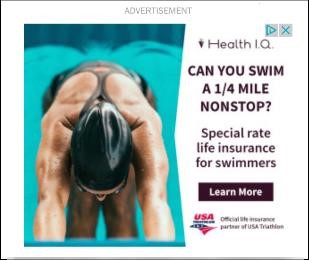
OK, I’m not much of a swimmer, but hmm. These guys know their audience.
Clearly, Health I.Q. was using these ads to segment its market -- healthy people of a certain age -- into runners, swimmers, triathletes, weightlifters, vegans, etc. Each ad aimed at a specific group of people, and the pictures and text matched that group.
Takeaway #2: Match Your Landing Pages to Your Ads
A core rule with pay-per-click campaigns is to sync your ad and your landing page. You don’t want somebody to click on your ad and land on a page that has nothing in common with the ad. That’s a great way to waste money.
When I finally clicked on the runner’s ad, I landed on a perfect match:
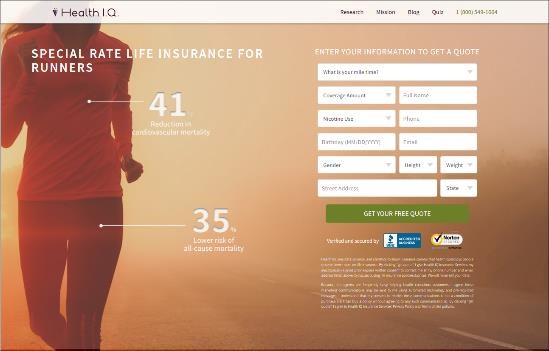
In this simple, but elegant and effective page:
- The “hero” image shows who the page is for (a runner).
- The text clearly states the value proposition: Special rate life insurance for runners.
- And why do runners get a special rate? Because they’re more heart-healthy (41%) and less likely to die early (35%).
The ad makes you feel like part of an elite. You’re a runner. You’ll live longer AND get to save money on life insurance.
Health I.Q. aimed at least five different ads at runners. They all take users to this same landing page. Even though the ads differ slightly, the landing page resonates with all of them. You’re a runner; you get special life insurance rates.
Takeaway #3: Build a Sense of Community
As you scroll down the landing page, you see a company full of people just like you – health-conscious runners. And they’re celebrating “unsung heroes” – that is, you.
Hey! I’m not just a runner – I’m an unsung hero!
If you’re not feeling smug yet, you should be. You’re special; you’re a runner; you’re joining a community of runners (people just like you!) to save money. Hooray for me!
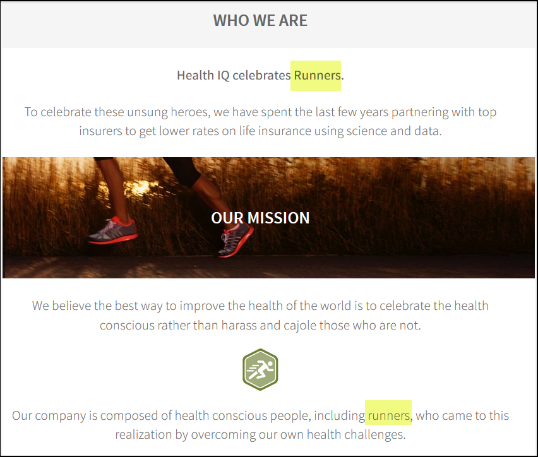
While the ads don’t show “social proof” (an endorsement from specific persons), the community-building aspect of their pages accomplishes the same result: You feel you belong.
Takeaway #4: Keep Your Landing Pages Simple and Easy to Change
All of Health I.Q.’s landing pages are similar. They speak to distinctly different audiences with changes to just four items:
- The hero image.
- Statistics related the health benefits of the particular athletic, dietary or other health practice. Note that Health I.Q. has done legit research; the stats differ in each ad. This enhances credibility.
- The sense of community – we celebrate runners; cyclists; etc. Change two words and it’s personalized to a different group.
- The banner image.
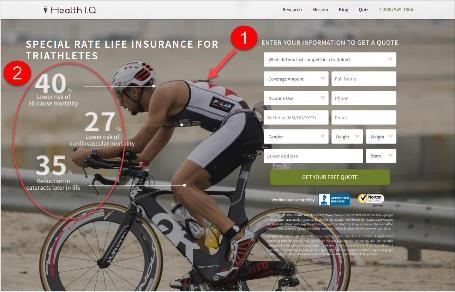
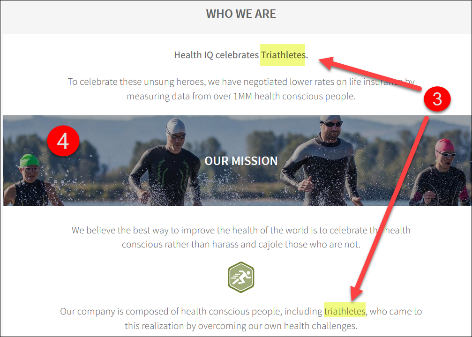
Here are some of the changed landing pages:
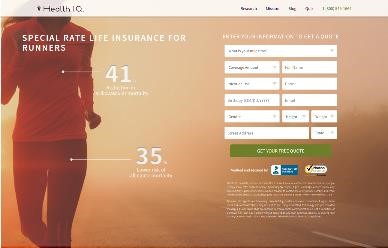
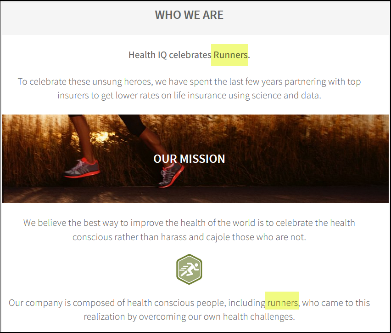
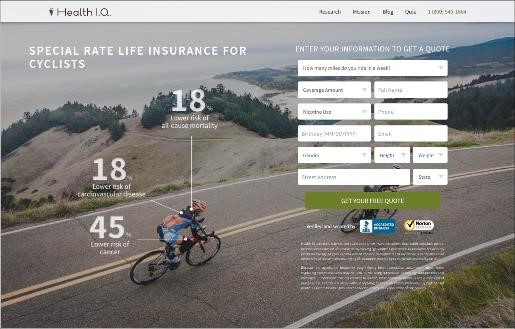
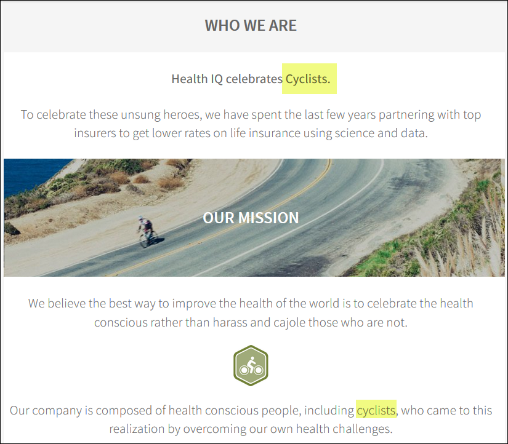
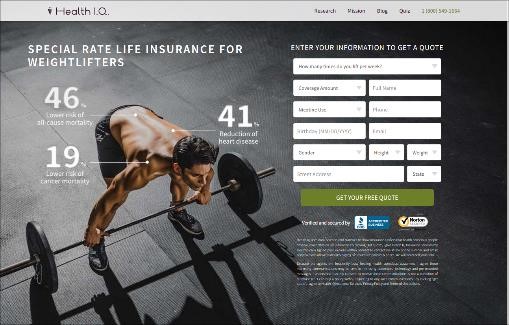
Some aim at vegans, vegetarians, and generally health-conscious people:
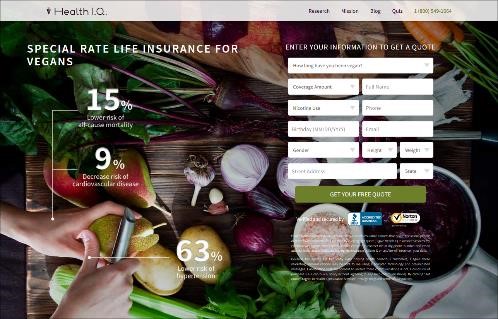
Change out two images and a bit of text, and you have a customized, audience-specific ad. Brilliant.
Takeaway #5: Test Your Ads
Another rule of PPC ads is to run at least two different ads to see which performs better. I can’t verify how many ads Health I.Q. is running, but I know the company aimed at least five at runners, including these three:
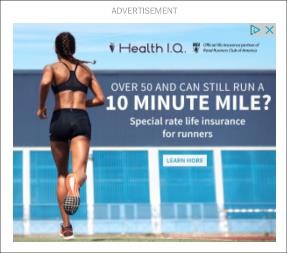
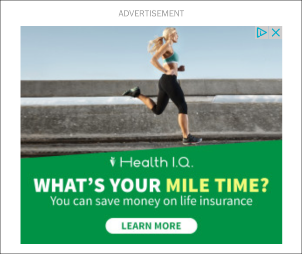
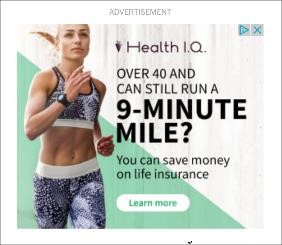
Given how well they're running their campaigns, I'm sure they're fanatical about tracking the effectiveness of the different ads. You can spot multiple A/B tests here:
- Test the main headline: "Over 50...?" versus "Over 40?..." versus "What's your mile time?"
- Test the subheadline: "Special rate life insurance..." versus "You can save money..."
Curiously, these ads, which have shown up in my Google ads feed, all show female runners. I can think of a few possible explanations for this:
- Testing has shown that females are Health I.Q.’s primary target audience, and we males get the same ads.
- Images of attractive, athletic women catch the eye of men over 40.
- Google did a good job of guessing my age but got the gender wrong.
Takeaway #6: Verify Your Audience
After I had filled out the insurance form, I faced a challenge. To qualify as a runner, and to take advantage of these special life-insurance rates, I had to prove I was a runner. These guys are serious.
To prove my bonafides, I could:
1. Send in a screenshot from a fitness tracker. Garmin, Fitbit, Apple Health data – basically any data that would show recent workout results.
Athletes tend to be compulsive about tracking their times and performance metrics. Luckily, I had one stat sheet showing sub-9-minute miles.
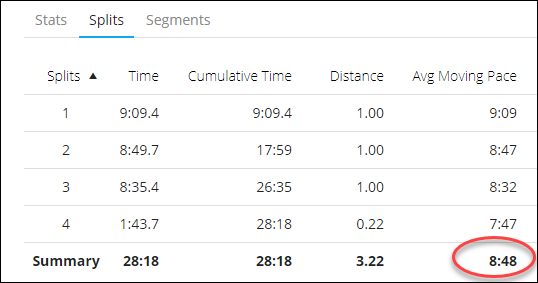
2. Prove that you know something about being a runner. You have to pass a test! Health I.Q. gives you up to one minute to answer each of 15 questions. That’s more than enough time if you’re actually an athlete -- and not enough time to Google the answer.
I’m not rabid about training. But I’ve been a cyclist and runner long enough, and I’ve read enough articles in Runner’s World and Bicycling Magazine, that the quiz was fairly easy for me. I got 13 out of 15 right.
Talk about feeling special! And talk about being an engaged prospect/customer!
These entry hurdles also screen Health I.Q. prospects and admit only those who fit the company’s business model.
Takeaway #7: Fish Where the Fish Are
So far we’ve looked at ads on the Display Network. What about the search network? Health I.Q. has active campaigns there, too. Consider the one aimed at bicycle riders.
The company’s keyword group does not relate to cyclists looking for life insurance. Instead, the keywords target people searching for bike insurance. If they seek bike insurance, they likely own high-end bikes. If they own high-end bikes, they probably ride a lot. If they ride a lot, they’re into fitness. If they’re into fitness, they are fit to join that elite cohort of Health I.Q. subscribers. And they might be attracted to life insurance at elite rates.
Note the keywords Health I.Q. chose in one of their ad groups:
- cyclist insurance
- cycle insurance quotes
- classic bike insurance
- bicycle shop insurance
- bike travel insurance
- sports bike insurance
- insurance bikes
- bike rental insurance
- insurance bike
- bikes insurance
- best bike insurance
This is the ad that shows up for those keywords:

Choosing keywords not specific to life insurance offers two main advantages to Health I.Q.
First advantage: Cost
Health I.Q. does go after such terms as “life insurance for cyclists,” as shown here:
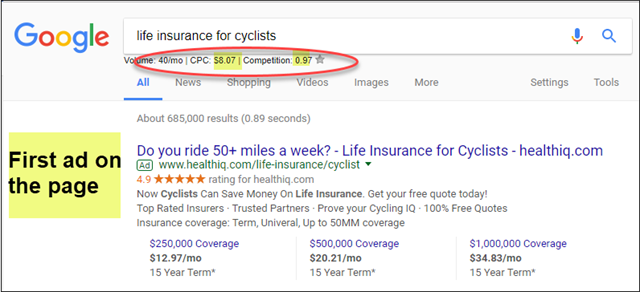
At $8.07, that’s a relatively expensive term, with a lot of competition (97%). And in this instance, they’re the top ad on the page, a potentially expensive spot.
They also went after much less expensive and less competitive keywords:



Not only are those terms less expensive, they are more frequently searched (the monthly volume is higher).
As long as Health I.Q.’s ads make it super-clear they are about life insurance and not bike rental insurance, they have a good chance of attracting clicks only from people who want life insurance. I suspect they’re succeeding.
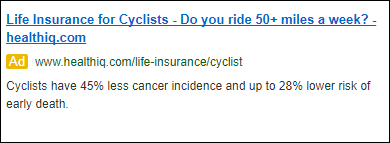
Second Advantage: Ad Position (and cost)
Note that in the “life insurance for cyclists” keyword ad above, Health I.Q. holds the top ad – probably an expensive position.
With the other semi-related keywords Health I.Q. is targeting, their ads are not showing up atop the list of ads, presumably on purpose. At least, that’s the strategy that I would take.
Here they’re third on the list of ads:
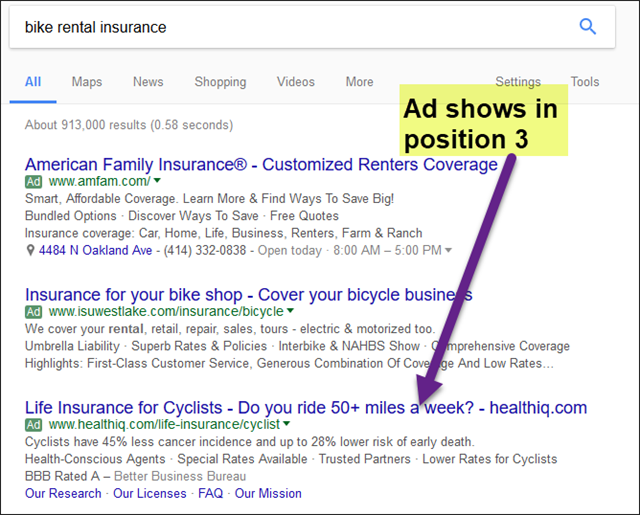
And here they’re on the bottom of page 1 (1o1 in AdWords parlance) – probably very inexpensive:
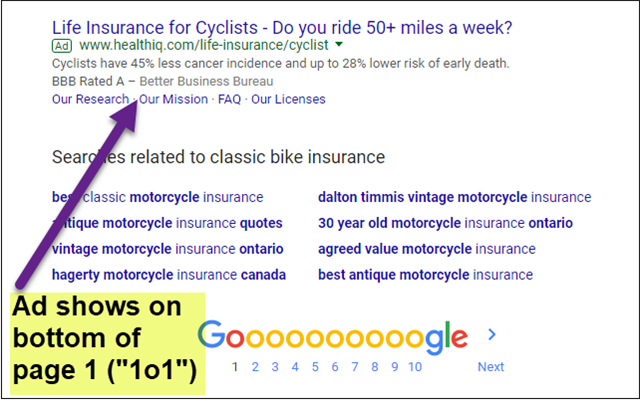
Health I.Q. doesn’t have to be as competitive for these supplementary keywords (e.g., “bicycle travel insurance”) because that’s not their business. They’re just casting a wide net and hoping to attract athletes who started out looking for something other than life insurance.
In fact, Health I.Q. shouldn’t want to be in the top two ad positions, as people are likely to click on those ads without reading them closely. The third or fourth position or on the bottom of page one? That’s exactly where they want to be with these semi-related keywords.
Summary
Health I.Q. is running a simple but highly effective Display Ad campaign to target specific market segments. The company follows the basic rules of good PPC campaigns (e.g., run multiple ads; match ads to landing pages). But the simplicity of the landing pages makes the campaign shine.
I can’t speak to how well they’re converting people once they sign up for more information on life insurance; again, I have no connection to Health I.Q. and no access to its metrics.
But I love how well they run ad campaigns and I’ve learned from them. I will apply those lessons to my own campaigns. You should, too.